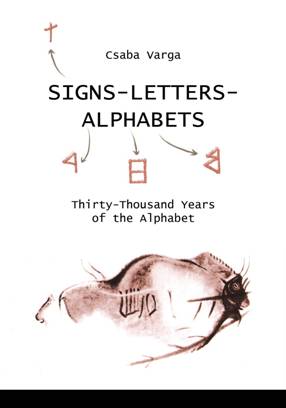
"Facts
are the most fascinating things in the world” (Molière)
THE MOST ANCIENT WRITTEN RECORDS
(Out of the book: Csaba Varga “Signs, Letters, Alphabets”)
Ordering the book possible in US or UK:
www.createspace.com/3389848
This slab below can be
seen in the Pont d’Arc cave-museum and is approx. 30.000 years old.
(The paintings and other objects found in the cave are estimated to
be 35-30.000 years old. They might be older; however, it is quite
sure that they are not less than 30.000 as afterwards no man had set
foot in the cave prior to the moment of its discovery. This way,
statistically speaking the slab “turns out to be” 32.500 years of
age, but to be careful I will say the find is 30.000 years old)
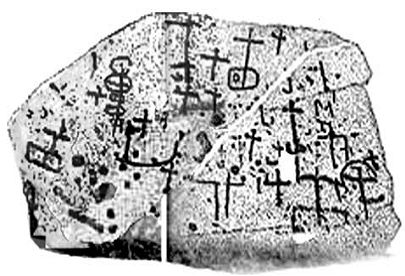
The slab of Pont d’Arc.
Most of the signs written on it are still exactly recognizable.
It is without doubt that
it was a human to carve those signs on the stone – they cannot be
accidental scratches, or heaven forbid, impressions of seashells.
There should be one person in front of our eyes who is sitting down
to some comfortable place and starts thinking. The arcs and the
firmly drawn lines all suggest that their designer was experienced
indeed in activities of the kind. The scribe did not put down a
coherent text but was simply experimenting with the characters.
On the weather-beaten
stone only the ligatures below are totally identifiable:

Let me enumerate below
the signs of the ligatures and the individual signs:

I only took into
consideration the signs that are clearly identifiable.

According to the above
connotations, the meaning of the ligature is the following:
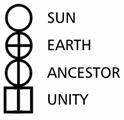
This is unquestionably
the conceptualization of a philosophical world-view. My solution
cannot be far from the truth, although there is no evidence that
these
signs meant the same back then.
* * *
The painting and the
text written on the bison were made around 20.000 BC, and found in
the cave of Pech Merle in today’s Southern France.
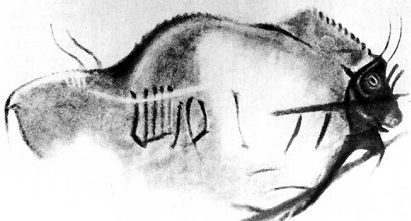
As a first step, the
signs need to be cleaned from their stylistic marks. The slightly
curved lines of the two middle signs can easily be straightened as
they would only make a meaningful difference in case of carefully
applied styling and not in a casual hand. The ornamentation of the
line-endings hardly performs any phonetic role. This act of cleaning
is shown in the figure below:

Of the signs I need to
explain only the “hand” character – or geometrically speaking the
“comb-hand” –. I present a couple of examples to show just how often
this character had already appeared in a variety of texts 10-18.000
years earlier:

This is a Portuguese, 12-14.000-yearold character.
The “comb” is the same as the one on the bison;
even the strong emphasis on the thumb is there.

Drawn and the cuneiform
versions of an
approx. 5.000-year-old (or older) Sumerian
sign. It represents a word and a syllable
sign here. And its meaning: “su” = hand.

An ancient Greek sign
representing the
“no” syllable. (It is a mystery why the
direction of the hand is reversed. Other
places the thumb points to the left)
|
ai
se |
 |
Two Cyprian syllabic
signs from 4.000 years earlier.

A collection of signs from various places.
All of these signs had been writing signs, of course.
These series of
remarkable concurrence of different times and places (I could
present a number of other instances too) can only be explained in
one way: in the ancient “comb” sign people had always “visioned” the
human hand.
We could 13 signs
encounter, which are 30.000 or more years old. Those signs were
present in the old but still used “alphabet” of the Carpathian Basin
6-8000BC, the Old-Egyptian Demotic, Aramaic, old Hebrew, all Greek
variations and finally in the early Latin alphabet. Etruscan and
Latin used only 18 letters, not much more, as the early ancestors.
Sumerians used those signs making ligatures to write their syllables,
but the early Sumerian signs looked just like them.
See more finds and further explanations in the book “Signs –
Letters - Alphabets” by Csaba Varga.

The letter collection (LC)
Signs collected from different artifacts of the last 35.000 years.
* * *

Found
in Mas’d Azil.
* * *

Signs
of the old-Egyptian demotic alphabet.
* * *
|
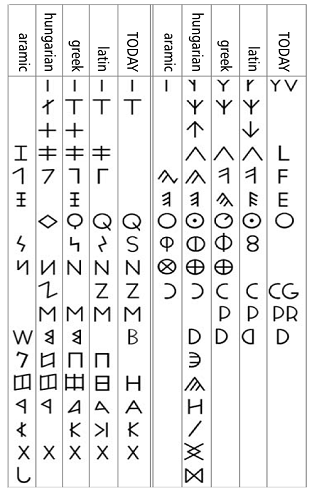 |
The
“ancient Hungarian” attributive in the enumeration left is confusing.
Generally, early records refer to this alphabet as Szekely-Hungarian,
Hunnish-Szekely, Hunnish-Szekely-Hungarian, Hunnish-Scythian.
As this alphabet is fashioned to fit the Hungarian language, just
like the
Ancient Greek alphabet fits the Greek-, the Aramaic alphabet the
Aramaic-,
and the Latin alphabet the Latin language, it is reasonable that
instead of the many kinds of old definitions, I call the alphabet
fashioned for the Hungarian language the “Hungarian alphabet.”
The more so because the modern Latin alphabet used in Hungary today,
is quite a latecomer in Hungarian history.
With this name-simplification I also want to stress that in this
book the
political maps and the present day-centered approach were given no
role.
From the signs of the enumerated four alphabets at the left I
mainly
Consider those that appear at least in two alphabets. With a couple
of exceptions.
|

The
above series comes together after the contraction of the four
alphabets:
This is the Hypothetic alphabet, the HA, and from now on I will
correlate all
newly found signs with the above. Anima
Könyv:
Signs-Letter-Alphabets |